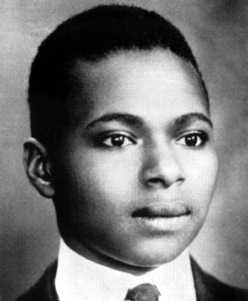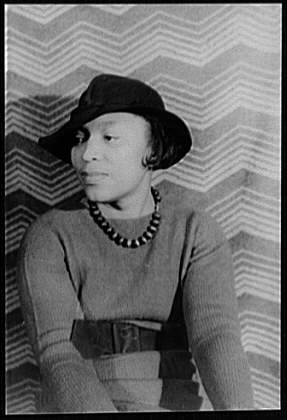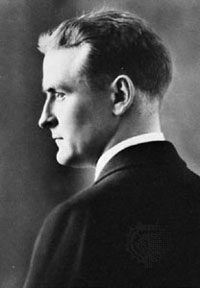LITR 5535 American Romanticism

Monday 2 May: Claude McKay, N 2082-2086. Zora Neal Hurston, N 2096-2109. Jean Toomer, N 2120-2126. Langston Hughes N 2225-2232. Countee Cullen, N 2245-2249. F. Scott Fitzgerald, N 2126-2143 (“Winter Dreams”).
| Devon's baby + research projects Harlem Renaissance poetry: Crystal Reppert evaluations [break] review of class Fitzgerald reader: Brouke Rose-Carpenter final exam Transcend! |
|
Monday 27 November: Claude McKay, N 2082-2086. Zora Neal Hurston, N 2096-2109. Jean Toomer, N 2120-2126. Langston Hughes N 2225-2232. Countee Cullen, N 2245-2249; F. Scott Fitzgerald, N 2126-2143 (“Winter Dreams”).
selection reader / discussion leader: Brouke M. Rose-Carpenter
poetry: Gwendolyn Brooks, "kitchenette building," N 2698
poetry reader / discussion leader: Crystal Reppert
questions assigned last week:
McKay, Hurston, Toomer, Hughes, Cullen are all associated with the "Harlem Renaissance," the great movement in African American literature in the 1910s-20s
"Romanticism" is a European-American inheritance. How well does it fit an African American movement?
How vary light-dark values of European gothic?
(That is, European gothic traditionally associates white or light with good and black or dark with evil. It's obvious that this is a loaded equation for an African American writer, so how do authors of the Harlem Renaissance work with such forms?)
Beware "primitivism"--the glorying of the exotic, akin to slumming
F. Scott
Fitzgerald associated with "Jazz Age," which connects a little with
Harlem Renaissance through jazz institutions like the Cotton Club and jazz
masters like Duke Ellington and others.
Fitzgerald—last blossoms of Euro-Am Romanticism?
How has Realism changed Romanticism? To what areas is Romanticism limited?
Monday 4 December: Final exam. Students may take final exam in-class or by email.
Devon's baby +
Email from last Tuesday, 21 Nov.
Bonnie Napoli
Hello, Bonnie, I hope you've been OK or coping. Of course I
remember the tragic loss that hit you a month ago . . . . I told the class
briefly and carefully about your situation based on what you told me over the
phone when the crisis had just occurred and you yourself were unclear exactly
what had happened. Otherwise we've just wondered if you'd reappear, but with
such a big class we've had plenty to do, so no problem beyond wanting to know
what to think. You're always welcome back to a classroom of mine--
Hi Dr. White,
. . . Unfortunately, I had to drop my classes. . . . All of my work was
put off and I got too behind, stressed, depressed, and worried. I just had to
put everything on hold this semester. This was my first semester of graduate
school, and on top of that stressor, all this other stuff came into play.
Thank you for inviting me back to any future classes. I plan to return in the
spring, if the school will have me back. : )
review research projects
will be read and returned before final exam date (next Monday, 4 Dec.)--probably by Thursday or Friday
Welcome to continue to correspond or confer about project or its future development
students may ask for any webpage contributions to be removed after final grade reports are sent out.
students may also substitute revised versions of submissions.
Harlem Renaissance
Today: Harlem Renaissance--
In course on "American Romanticism," inclusion of Harlem Renaissance stretches concepts
African American writers work closely with but vary European categories of order and aesthetics
Typically Harlem Renaissance would not be studied as Romantic phenomenon but within several other traditions or lines of study:
African American or Minority Literature
Modernism (1st half of 20th century)
Interdisciplinary or multi-media movement: not just literature but music (jazz), theater, and visual art, not to mention study of cultural movement involving migration of many rural or southern blacks to northern urban centers.
(As a result of this last aspect, much Harlem Renaissance material is finding a home on the web--literature + visuals + sound.)
backgrounds "Harlem Renaissance" . . .
first, the period: generally the 1910s-20s
How it starts or develops: Large numbers of rural and southern African Americans move to northern cities in early 20th century, partly to escape segregation, partly for economic opportunity created by World War 1 (1914-18).
How it ends: Great Depression in 1929 wrecked patronage system and "fat of the land" on which a movement like the Harlem Renaissance survived, writers dispersed. (As with American Renaissance, though, most of the chief writers survived this period and kept writing, but less as a movement.)
Other terms or names for Harlem Renaissance:
"The New Negro Renaissance"--this term was used frequently during the time of the Harlem Renaissance. (p. 2096 Alain Locke, The New Negro, 1925)
"The African American Renaissance"
Advantages of other names: Renaissance not limited to Harlem; authentic widespread historical usage.
Disadvantages of other names: "Negro" seems always to be an awkward English word, and nearly everyone avoids it except in a historical sense, with "air quotes" around it.
--African American Renaissance is more inclusive but also drier and duller. . People remember "Harlem Renaissance" because it sounds like something real, has specificity and flavor, whereas "African American Renaissance" sounds like a scholarly construct. (Cf. "Regionalism" and "Local Color.")
*****
Questions:
"Romanticism" is a European-American inheritance. How well does it fit an African American movement?
How vary light-dark values of European gothic?
compare exercise to Romanticism and American Indians
1. European-Americans tend to romanticize the American Indian either positively or negatively
2. It is difficult to establish how much the American Indian really fits the categories of Romanticism, or how much it's simply a category that white writers make fit, and Indian writers occasionally exploit.
Insofar as Indians fit Romantic stereotypes, they're probably not being Indian at all but only white projections. Moments of Indian identity tend to be surprising, frustrating, or elusive to white expectations.
**************
Compared to Native American literature and culture, African American literature has developed in a closer (but not necessarily friendlier) relationship with European American literature and culture, so the interfaces between these two are more frequent and deep.
Zora Neal Hurston, N
2096-2109.
2100 cf. Emerson Whitman: cosmic Zora: no separate feeling about being an American citizen and colored; merely a fragment of the great soul
"The Gilded Six-Bits”
2100 yard raked
2102 drink Jordan dry
2103 Ah’m satisfied . . . .
2103 I ain’t never been nowhere
2103 his pretty womens—Ah want ‘im to see mine
2104 all, everything was right
[otherwise story hard to reduce to Romanticism]
Some points where study of Romanticism intersects study of African American literature. One can't be reduced to the terms of the other, but putting them into dialogue helps them inform each other, see each other differently.
How vary light-dark values of European gothic?
(That is, European gothic traditionally associates white or light with good and black or dark with evil. It's obvious that this is a loaded equation for an African American writer, so how do authors of the American Renaissance work with such forms?)
Beware "primitivism"--the glorying of the exotic, akin to slumming
Can instead use patterns and features of Romanticism / gothic / light and dark as base against which to differ or vary
2099 most colored when thrown against a sharp white background
2099 among thousand white persons, I am a dark rock surged upon
2099 so pale with his whiteness and I am so colored

Countee Cullen, 1903-46
One of my favorite poets since high school. He himself was a high school teacher for a while, and James Baldwin was one of his students!
Like Baldwin, Hughes, and others, part of a heavily closeted tradition of African American writers who are gay / homosexual
Early intrigue for me: Cullen wanted to be known as "the black Keats"
What's this mean?
John Keats, 1795-1821, exemplification of British Romantic poet, gift of pure aching lyricism in "Ode to a Nightingale," "The Eve of St. Agnes," "Ode to Autumn," etc.
For Cullen, this identification meant that, while he was an African American poet, his models were from European Romanticism. Contrast with a poet like Hughes, who used blues, jazz, gospel and other African American models--+ Whitman.
But in America, race has never yet been completely forgotten, so "Black Keats"
Exercise: 2 poems by Cullen that are both Romantic, but one emphasizes the "Keats" side of the equation, while the other emphasizes the "black" aspect.
First poem: "For a Poet"--How is it Romantic? Is there any element of the poem that reaches beyond Romantic themes to an expression of African American identity?
I have wrapped my dreams in a silken cloth,
And laid them away in a box of gold;
Where long will cling the lips of the moth,
I have wrapped my dreams in a silken cloth;
I hide no hate; I am not even wroth
Who found earth's breath so keen and cold;
I have wrapped my dreams in a silken cloth,
And laid them away in a box of gold.
Second poem: "From the Dark Tower"
How do Romanticism and African American identity meet? What's Romantic, and what's African American?
How vary light-dark values of European gothic?
We shall not always plant while others reap
The golden increment of bursting fruit,
Not always countenance, abject and mute,
That lesser men should hold their brothers cheap;
Not everlastingly while others sleep
Shall we beguile their limbs with mellow flute,
Not always bend to some more subtle brute;
We were not made eternally to weep.The night whose sable breast relieves the stark,
White stars is no less lovely being dark,
And there are buds that cannot bloom at all
In light, but crumple, piteous, and fall;
So in the dark we hide the heart that bleeds,
And wait, and tend our agonizing seeds.
Conclusion: not using Romanticism merely as an inclusive device that turns everything into itself but as a subject that can register difference
"Have to know the rules to break the rules"
Remaining business
1. review projects
2. preview final exam
3. evaluations
2. preview final exam
final exam scheduled for next Monday, 4 December 2006
in-class 4-7
email--submit by 8pm or notify why not
No absolute need for email students to wait until next Monday unless convenient.
Final exam now posted on course webpage:
You may use your own time between now and next Monday as most convenient.
Limits:
Spend only 3 hours writing. (Welcome to plan, outline, draft, arrange notes, review texts in preparation--no way to control!)
Keep a log of when you start and stop.
Email completed exam to whitec@uhcl.edu
Acknowledgement within 24 hours
Exams & final grade reports returned by late next week
Sample exams posted by selection--if yours not selected, not a negative judgment--Only I've collected so many by now that I can save labor for those that are doing something that hasn't been done before.
review of class / seminar
LITR 5535 American Romanticism first grad course I ever taught, when I arrived here in 1992
lucky subject--delicious texts--instructor only has to stay out of students' way
big subject: many ways to organize readings
> wide survey--lacks depth of more specialized courses, but each student will find some author or text to connect to
unifying concept of Romanticism: maintains traditional category of literary criticism
+ stretches familiar category to incorporate recent developments in literary studies
esp. race but also gender and class, however briefly
Why didn't I explain the course approach before?
always too much to say--limit explanations and dive into texts
+ now you're experienced enough to comprehend what we've been up to
As far as what I've learned, I've mentioned that the size of the class created some complications in methods, but each of you has been welcome and has cooperated
one response: reduce graduate seminar enrollment caps from 25 to 20
On plus side, perhaps owing to size of class, not sure I've ever had this talented a class, plus increasing diversity of student backgrounds
sometimes embarrassed at limits of my ability to respond, but take in stride
That sublime mix of pleasure and challenge that draws all of us back to literary studies
F. Scott Fitzgerald, N
2126-2143
F. Scott
Fitzgerald associated with "Jazz Age," which connects a little with
Harlem Renaissance through jazz institutions like the Cotton Club and jazz
masters like Duke Ellington and others.
Fitzgerald—last blossoms of Euro-Am Romanticism?
How has Realism changed Romanticism?
2128 [cf. slave attributes; ethnicity > class]
2128 Dexter x aren't very many people
2134 increased her value in his eyes
2139 put her behind him, as he would have crossed a bad account from his books
To what areas is Romanticism limited?
2127 the fairways of his imagination
(mind + landscape, but no longer the forest or sea . . . )
2128 shining through her thin frame in a short of glow
2130 wanted . . . the glittering things themselves . . . without knowing why he wanted
2131 a fish jumping and a star shining
2131-2 songs as culture referent
2132 ecstasy
2132 radiating a brightness and a glamour he might never know again
2132 pink rompers
2132 Watching her cf branch waving or sea-gull flying (cf. Poe 707)
2135 Her face seemed to open like a flower
2135 committed himself to the following of a grail
2135 Whatever the beautiful Judy Jones desired, she went after
2136 entertained only by the gratification of her desires
2137 No disillusion at to the world in which she had grown up could cure his illusion as to her desirability
2137 ecstatic happiness and intolerable agony of spirit
2138 [catalog] the thing was deep in him
2138 Judy a slender enamelled doll
2138 seemed to blossom
2139 he was filled . . .
2143 Long ago there was something in me . . . That thing will come back no more
Claude McKay, N
2082-2086.
2082 Jamaican, West Indians and Africans
2083 dialect poetry
2083 strict sonnet form
2083 compelling statements, also good poetry by traditional standards
Zora Neal Hurston, N
2096-2109.
2096 initiation into American racism (cf. FD, Harriet Jacobs); early security > core of self-confidence
2096 Alain Locke, The New Negro, 1925
2097 anthropology, storyteller, informal performing artist, oral narrative
2097 well-off white people were the sponsors of, and often the chief audience for, their work
2097 not entirely popular with male intellectual leaders of Harlem community
x-ideologies
2097 most important work mid 1930s when little interest in it
2097 no audience
“How it feels to be Colored Me”
2098 born first-nighter
2098 white people liked to hear me “speak pieces,” sing, dance
2098 now a little colored girl
2098 not tragically colored, sobbing school of Negrohood
2098 slavery 60 years in past, operation successful
2099 slavery the price I paid for civilization
2099 most colored when thrown against a sharp white background
2099 among thousand white persons, I am a dark rock surged upon
2099 contrast
2099 primitive fury, jungle, living in the jungle way
2099 veneer of civilization
2099 so pale with his whiteness and I am so colored
2100 cf. Emerson Whitman: cosmic Zora: no separate feeling about being an American citizen and colored; merely a fragment of the great soul
Jean Toomer, N
2120-2126.
2120 Toomer reconciled the two
2122 Fern as romantic heroine? Cf. Judy Jones
2123 I too had my dreams
2124 held me. Held God.
2124 Dusk hid her . . . .
2124 north-south
Langston Hughes N
2225-2232.
2225 Literary patterns x oral and improvisatory traditions
2226 working class solidarity that nullified racial boundaries
2227 cf. Whtiman long line
2228 darker brother
2229 sweet as earth / Dusk dark bodies
2230 black man, dark of moon, white womanhood
Countee Cullen, N
2245-2249
2245 traditional forms x black dialects or militant manifestos

